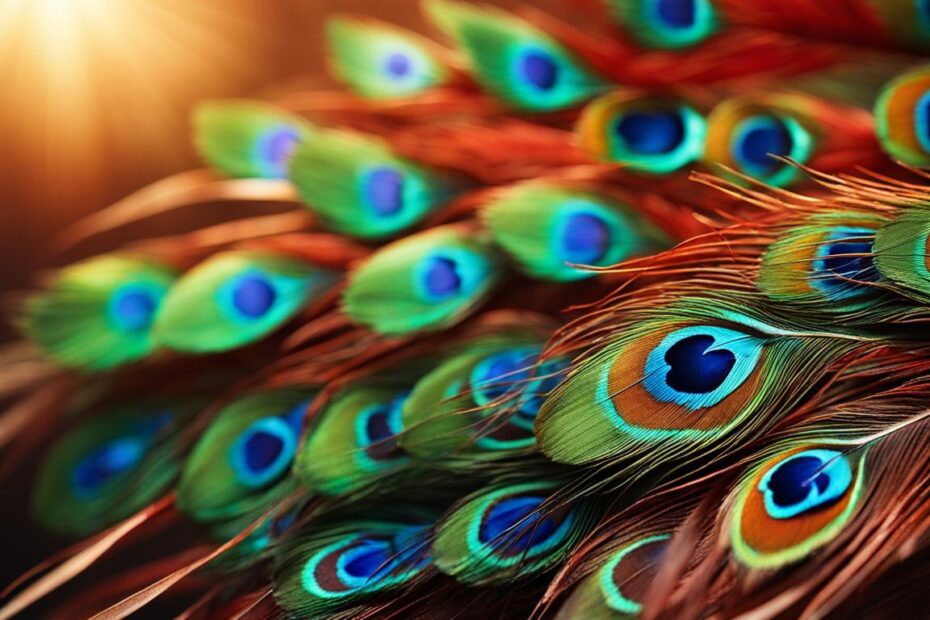Peafowl are known for their magnificent plumage and vibrant colors, which never fail to capture our attention. From the iconic blues and greens to rare color variations, these birds display an incredible range of hues. Let’s delve into the captivating world of peafowl colors and discover the fascinating patterns they adorn.
Key Takeaways:
- Peafowl exhibit a stunning variety of colors and patterns in their plumage.
- There are 225 recognized varieties of peafowl, including pattern and color mutations.
- Peacock feathers achieve their vibrant colors through structural coloration.
- Common colors of peafowl include blue, brown, green, and yellow (although true yellow peacocks do not exist).
- There are rare color variations like white, red, purple, and pink resulting from genetic mutations.
The Colors of Peacock Plumage
Peacock feathers display a stunning array of colors. They include vivid blues, lush greens, sparkling teals, and deep turquoise. The colors of peacock feathers are achieved through structural coloration, with tiny structures reflecting light to produce iridescent shades. Peacock plumage is known for its vibrancy and diversity, captivating artists, designers, and wildlife enthusiasts alike.
The vibrant colors of peacock feathers have long been admired for their beauty and elegance. Each feather showcases a combination of hues, creating a mesmerizing effect that captures the imagination. The intricate patterns and shades found in peacock plumage are truly a marvel of nature’s artistry.
Peafowl feathers not only exhibit a variety of stunning colors but also possess a unique iridescent quality. This iridescence is created by the interaction of light with the microscopic structure of the feathers. As light strikes these specialized structures, it is refracted and reflected, resulting in the vibrant and shimmering colors that make peacock plumage so captivating.
Whether it’s the rich blues reminiscent of a clear summer sky or the vibrant greens that bring to mind lush tropical foliage, peacock feathers continue to inspire and fascinate. Their vibrant colors and intricate patterns have made them a popular choice for fashion, art, and design, adding a touch of opulence and sophistication to any creative endeavor.
| Colors | Descriptions |
|---|---|
| Vivid blues | Resemble a clear summer sky |
| Lush greens | Evoke images of lush tropical foliage |
| Sparkling teals | Glimmer with a rich and vibrant hue |
| Deep turquoise | Delight with its intense and mesmerizing color |
“The vibrant colors of peacock plumage are a testament to the beauty and diversity found in the natural world. From the vivid blues to the lush greens, these feathers showcase the incredible artistry of nature. It’s no wonder they continue to captivate artists, designers, and enthusiasts alike.” – Wildlife enthusiast
Common and Rare Peacock Colors
Peafowl exhibit a wide range of colors, with some being more common while others are considered rare. The most common peacock color is blue, which is often associated with the iconic image of a peacock spreading its feathers in a display of vibrant hues. Other common colors found in peafowl include brown, green, and yellow, although it’s worth noting that true yellow peacocks do not exist. These colors are often found in the plumage of both male and female peafowl, with slight variations in shade and pattern.
However, peacock colors can also result from genetic mutations, leading to the development of rare and unique colors. These rare peacock colors include white, red, purple, and pink. These mutations occur due to changes in the peacock’s genetic code, resulting in alterations in the pigmentation of their feathers. While rare, these colors are highly sought after for their distinctiveness and beauty.
The coloration of peafowl feathers is influenced by both hereditary factors and structural coloring. Structural coloration refers to the way light interacts with the microscopic structures in the feathers, creating iridescent shades that change depending on the angle of light. This structural coloration, combined with the genetic mutations, contributes to the stunning variety of peacock colors that we observe in these magnificent birds.
| Common Peacock Colors | Rare Peacock Colors |
|---|---|
| Blue | White |
| Brown | Red |
| Green | Purple |
| Yellow (not true yellow) | Pink |
“The stunning variety of peacock colors, from the common to the rare, is a testament to the beauty and diversity of nature. Each color has its own unique charm, captivating all who behold these magnificent birds.” – Peacock Expert
The Peacock’s Crest: A Sensory Wonder
The peacock’s crest is not just a decorative feature – it serves important sensory functions as well. Made up of specialized feathers, the crest helps peafowl detect vibrations, communicate with each other, and avoid predators. This remarkable adaptation showcases nature combining form and function in a truly captivating way.
The crest feathers of a peacock are designed to respond to sound waves and air movements, enhancing the bird’s ability to perceive its surroundings. The feathers are long and slender, with a distinct shape that sets them apart from the rest of the plumage. These unique feathers contain sensory cells that can detect even the slightest vibrations, allowing the peacock to remain alert and responsive to its environment.
This sensory wonder of the peacock’s crest is a testament to the incredible diversity and complexity of avian adaptations. It showcases the remarkable ways in which birds have evolved to navigate their surroundings and thrive in their habitats.
The Functionality of the Peacock’s Crest
The crest feathers of a peacock serve as antennae, allowing the bird to detect vibrations and movements in the air. This sensory information helps them navigate their environment, locate potential threats, and communicate with other birds.
The crest feathers are highly flexible, with specialized muscles that allow the bird to move them independently. This enables the peacock to create a variety of display patterns, from erecting the crest during courtship rituals to flattening it during times of rest or when trying to blend into its surroundings.
The vibrant colors and intricate patterns of the crest feathers also play a role in visual communication. During courtship displays, male peacocks unfurl their crests to create a striking visual spectacle that attracts the attention of potential mates. The crest’s iridescent hues and eye-catching patterns make it a powerful tool in the peacock’s quest for reproduction.
The peacock’s crest exemplifies the beauty and functionality that can be found in nature. It is a sensory wonder that not only adds to the aesthetic appeal of these magnificent birds but also enhances their survival and reproductive success.
A Visual Overview of the Peacock’s Crest
| Characteristic | Description |
|---|---|
| Feather Structure | The crest feathers are long, slender, and distinct in shape, differentiating them from the rest of the plumage. |
| Sensory Function | The crest feathers contain sensory cells that can detect vibrations, helping the peacock remain alert and responsive to its environment. |
| Movement | The crest feathers can be moved independently by specialized muscles, allowing the bird to create a variety of display patterns. |
| Visual Communication | The vibrant colors and intricate patterns of the crest feathers play a role in attracting potential mates during courtship displays. |
The peacock’s crest is a sensory marvel that showcases the fascinating adaptations found in the avian world. Its unique structure, functionality, and visual appeal make it an integral part of the peacock’s existence and a symbol of nature’s ingenuity.
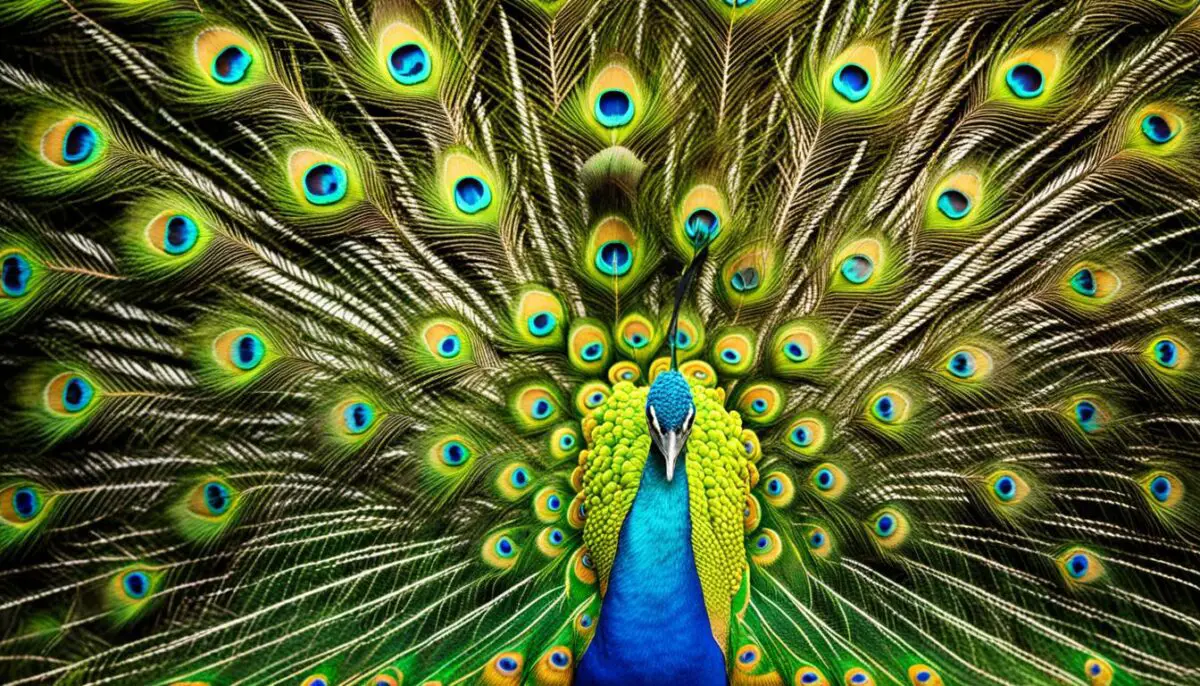
Obtaining Peacock Feathers: Ethical Considerations
Peacock feathers have long been admired for their beauty and uniqueness. They have been used in various cultural practices, from fashion and home decor to religious ceremonies. However, obtaining peacock feathers raises important ethical considerations that should not be overlooked.
First and foremost, the welfare of the birds must be taken into account. Peacock feathers are typically obtained through molting, a natural process where the bird sheds its old feathers to make way for new ones. However, there are cases where birds may be subjected to forced molting or live plucking, which causes unnecessary stress and pain. It is crucial to source feathers from reputable suppliers who adhere to ethical practices and prioritize the wellbeing of the birds.
Another concern is the impact on the environment. Peacocks are native to certain regions and play a vital role in maintaining the ecological balance of their habitats. The demand for peacock feathers can lead to over-harvesting, habitat destruction, and disruption of natural ecosystems. Sustainable sourcing and responsible harvesting practices are essential to minimize the negative environmental impact.
“We must be mindful of the impact our actions have on these majestic creatures and the environment they inhabit.”
Additionally, peacock feathers hold significant cultural and spiritual importance in many societies. They are deeply rooted in tradition and symbolism. It is crucial to respect and honor these cultural practices when using peacock feathers, ensuring that they are obtained and used in a manner that aligns with cultural sensitivities and traditions.
It is important to strike a balance between appreciating the beauty of peacock feathers and respecting the ethical considerations surrounding their procurement. By sourcing feathers responsibly, supporting conservation efforts, and being aware of cultural significance, we can ensure that the allure of peacock feathers can be enjoyed in a sustainable and respectful manner.
| Considerations | Actions |
|---|---|
| Welfare of the Birds | Source feathers from reputable suppliers who adhere to ethical practices and prioritize bird welfare. |
| Environmental Impact | Ensure sustainable sourcing and responsible harvesting practices to minimize negative environmental consequences. |
| Cultural Significance | Respect and honor cultural practices and traditions associated with peacock feathers. |
Types of Peacock Species
Peafowl are known for their stunning plumage, with each species exhibiting unique characteristics and colors. The three main species of peacocks are the Indian peafowl, the green peafowl, and the Congo peafowl. Let’s take a closer look at each species:
Indian Peafowl
The Indian peafowl, also known as the common peafowl or the blue peafowl, is native to the Indian subcontinent. It is the most well-known and widely recognized species of peacock. The male Indian peafowl is famous for its vibrant blue and green plumage, which features elaborate eye-spots and long, colorful train feathers. These feathers are often displayed in a fan-like pattern during courtship rituals. The female Indian peafowl, known as the peahen, has more subdued colors and lacks the extravagant train feathers of the males.
Green Peafowl
The green peafowl, also referred to as the Javanese peafowl, is native to Southeast Asia. This species exhibits a striking green and metallic blue coloration. The males have a distinct crest on their heads and shorter train feathers compared to the Indian peafowl. The female green peafowl shares a similar color palette with the males but lacks the extravagant train feathers.
Congo Peafowl
The Congo peafowl, also known as the African peafowl, is found in the forests of central Africa. This species has a more subtle coloration compared to the Indian and green peafowls. The males display iridescent blues and purples on their feathers, with a unique elongated crest on their heads. The females have a brownish coloration with hints of green and blue. The Congo peafowl is the smallest of the three species.
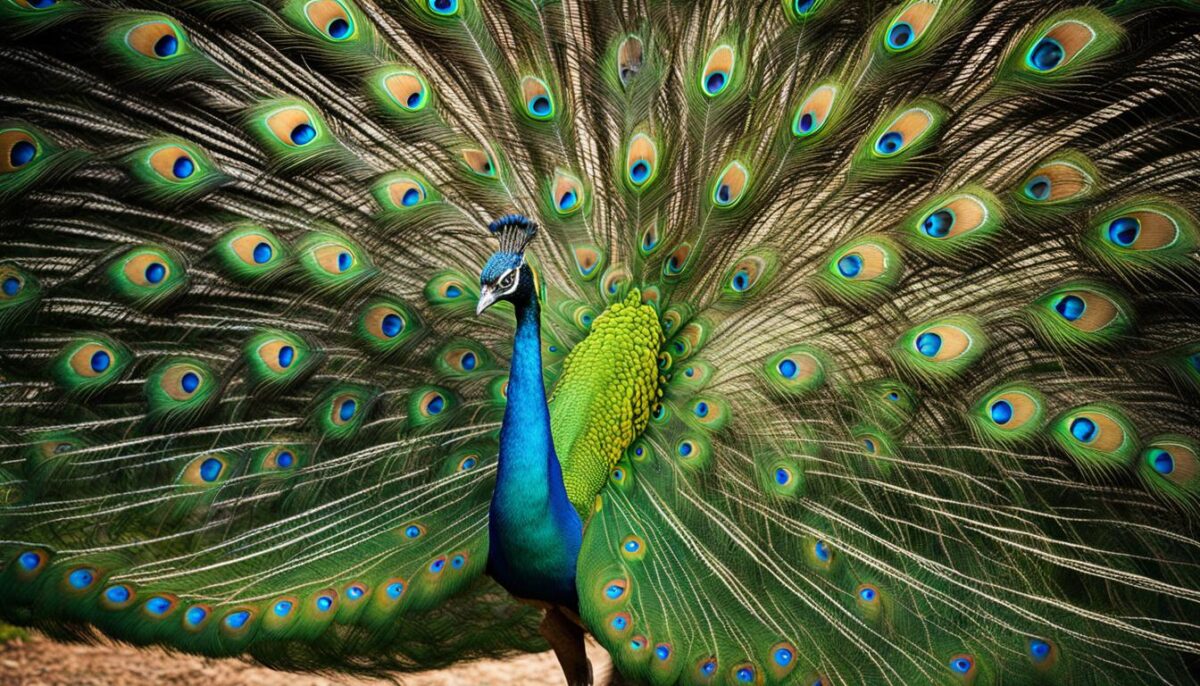
In summary, the Indian peafowl, green peafowl, and Congo peafowl each possess their own distinct beauty and charm. Their vibrant displays of colors and intricate feathers make them truly remarkable creatures.
The Development of Peacock Plumage
Peacocks, known for their vibrant and captivating feathers, do not display their full splendor from birth. The development of peacock plumage occurs over time, with feathers reaching their brightest and most colorful stage at around 6 years old. This process is influenced by various factors, including age, genetics, and environmental conditions.
Feathers start growing when peafowl are approximately 3 years old, gradually transforming from dull and muted tones into the dazzling hues that peacocks are renowned for. As the birds mature, their feathers undergo a remarkable transformation, with structural coloration playing a crucial role in the display of vibrant shades.
Structural coloration is a phenomenon where the microscopic structures within feathers reflect and scatter light, creating iridescent colors that seem to change depending on the viewing angle. These structures can be complex, with unique patterns and arrangements that contribute to the overall beauty of the plumage.
“The development of peacock plumage is a fascinating process. It showcases the intricate interplay between genetics, age, and environmental factors that shape the stunning colors and patterns seen in adult peafowl.” – Dr. Avian Researcher
The Timeline of Feather Growth
To better understand the development of peacock plumage, it’s helpful to explore the timeline of feather growth. At around 3 years old, peafowl begin growing their first set of adult feathers, known as the train feathers. These are the long, colorful feathers that form the impressive train displayed during courtship rituals.
Over the next few years, these train feathers continue to grow and develop, reaching their peak in vibrancy and length. By the age of 6, peacocks exhibit their most dazzling and fully mature plumage, attracting mates and asserting their dominance within the peafowl community.
The timeline of feather growth can vary slightly among individual peafowl, influenced by factors such as overall health, diet, and environmental conditions. However, the general progression from dull juvenile feathers to vibrant adult plumage follows a consistent pattern.
Factors Influencing Feather Color
Several factors influence the coloration of peacock feathers. One of the key factors is genetics, as certain genes determine the pigments present in the feathers. Genetic variations can lead to a wide range of color possibilities, from the iconic blues and greens to rare hues like white or red.
Environmental factors also play a role in feather coloration. The availability of certain nutrients and trace elements in the peafowl’s diet can impact the intensity and brightness of their plumage. Additionally, exposure to sunlight and environmental pollutants can affect the overall appearance of the feathers.
It’s important to note that the natural coloration of peafowl feathers remains consistent throughout their lives. Unlike some birds that molt and grow new feathers each year, peafowl retain their vibrant plumage, allowing them to display their beauty year-round.
| Factor | Influence on Feather Color |
|---|---|
| Genetics | Determines pigments and variation in color |
| Environment | Affects intensity and brightness of plumage |
| Nutrition | Availability of nutrients impacts feather color |
| Sunlight and Pollutants | Can affect overall appearance of feathers |
The development of peacock plumage is a remarkable process that showcases the intricate interplay between genetics, age, and environmental factors. From their early growth stages to the vibrant hues exhibited in adulthood, peacocks exemplify nature’s ability to create stunning displays of color and beauty.
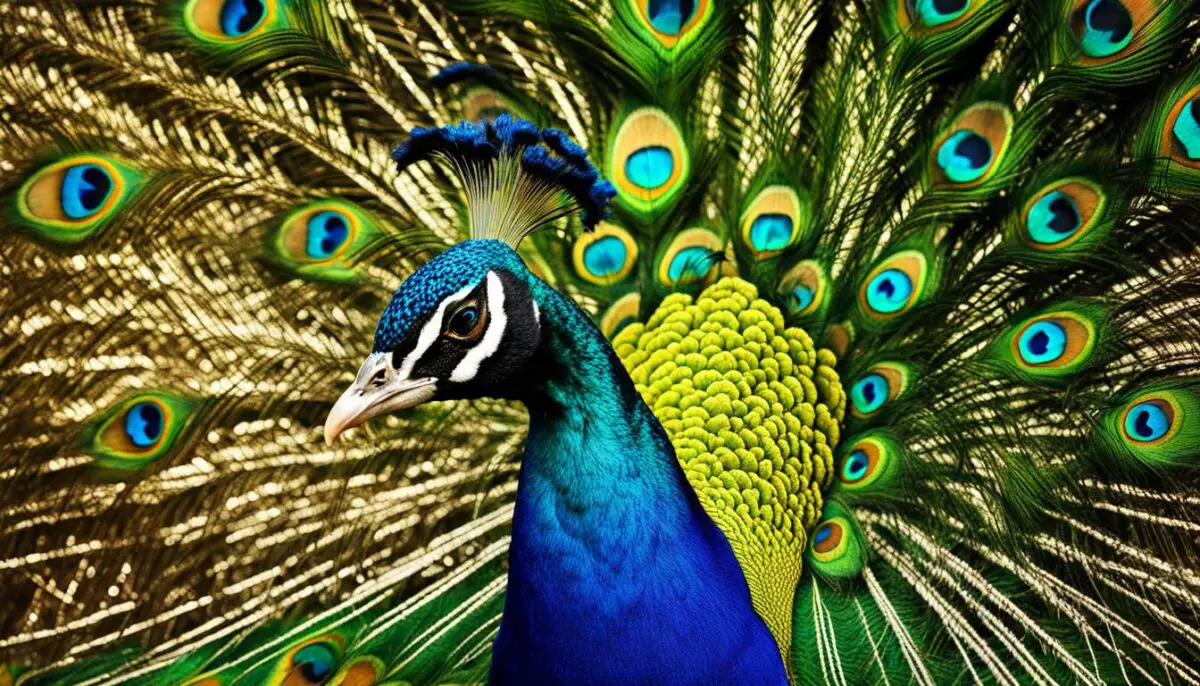
Distinguishing Male and Female Peafowl
Male and female peafowl, commonly known as peacocks and peahens respectively, can be distinguished by their appearance, particularly their plumage. This distinction is known as sexual dimorphism. The male peacock displays vibrant, colorful feathers that are an exquisite display of nature’s artistry. In contrast, the female peahen possesses more muted and camouflaged feathers that allow her to blend into her surroundings for protection.
Peafowl plumage plays a crucial role in mating rituals and courtship displays. The male peacock uses his stunning plumage to attract the attention of females, who select mates based on the quality and vibrancy of their feathers. The elaborate courtship dance of the male, which involves fanning out his feathers and displaying them in a breathtaking spectacle, is designed to impress and win the favor of the female. This display of beauty and vitality serves as a visual representation of the male’s genetic fitness and overall health.
While the male’s plumage is renowned for its vibrant colors, the female’s more subtle appearance is an adaptation for nesting and protecting her young. The camouflaged feathers of the peahen allow her to blend into the vegetation, providing a level of protection against predators while she tends to her eggs. This natural selection has shaped the distinct appearances of male and female peafowl, ensuring their survival and successful reproduction.
Table: Comparison of Male and Female Peafowl
| Feature | Male (Peacock) | Female (Peahen) |
|---|---|---|
| Plumage | Vibrant, colorful feathers | Muted, camouflaged feathers |
| Size | Larger and more prominent | Smaller and less elaborate |
| Display | Elaborate courtship dance | Observes the male’s display |
| Role | Mating attraction and competition | Nesting and protecting the young |
In conclusion, male and female peafowl can be easily distinguished by their plumage. The male, or peacock, boasts vibrant and colorful feathers that serve as a visual spectacle to attract mates. In contrast, the female, or peahen, possesses a more subdued appearance that aids in nest protection and blending into the environment. Together, the distinct appearances of male and female peafowl add to the intriguing beauty and complexity of these remarkable birds.
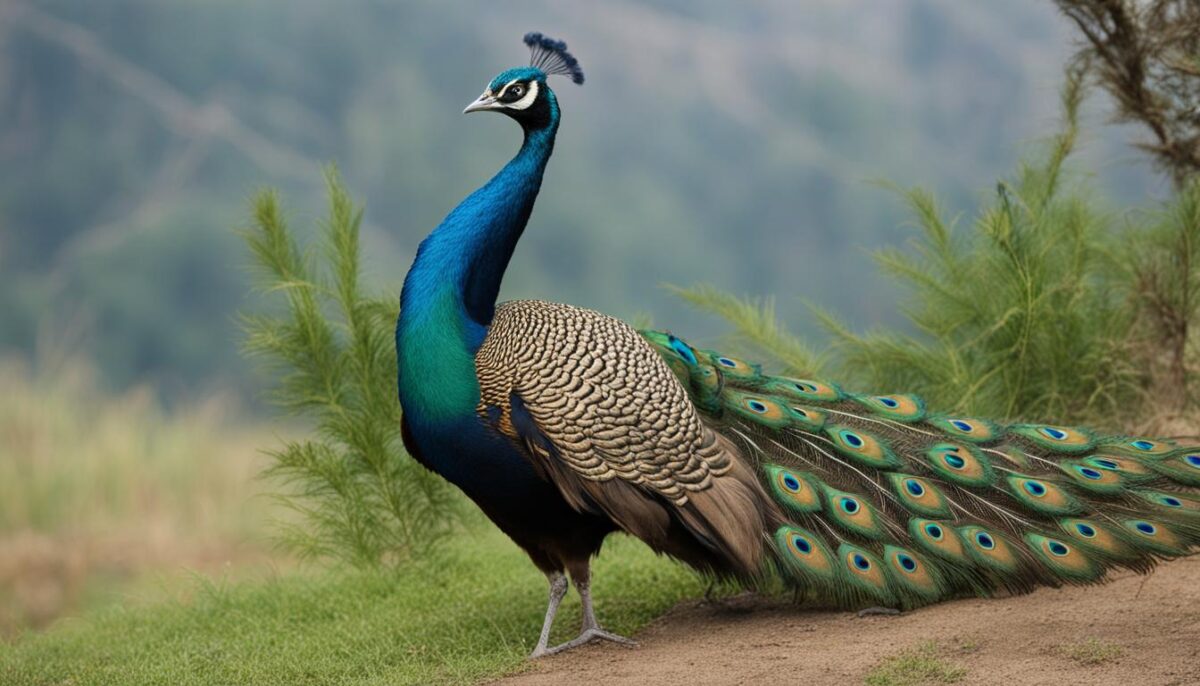
Lesser-Known Peacock Varieties
While the Indian peafowl, green peafowl, and Congo peafowl are well-known species, there are other unique and fascinating peacock varieties that are lesser-known. One such variety is the Javanese Green Peafowl. This remarkable peacock species is native to the island of Java in Indonesia and is known for its distinctive appearance.
The Javanese Green Peafowl, also known as Pavo muticus muticus, is characterized by its vibrant green feathers that have a metallic sheen. The male Javanese Green Peafowl has a long and magnificent train with iridescent green and blue feathers, while the female has a more subdued coloration. This peacock species exhibits sexual dimorphism, where males and females have different appearances.
The Javanese Green Peafowl is not only visually striking but also holds cultural significance. In Javanese mythology and folklore, this species is revered as a symbol of nobility, beauty, and protection. The Javanese people consider the presence of the Javanese Green Peafowl as a sign of good fortune and abundance.
The conservation status of the Javanese Green Peafowl is currently classified as vulnerable due to habitat loss, fragmentation, and poaching. Efforts are being made to protect and conserve this unique species and its habitat. By raising awareness and supporting conservation initiatives, we can contribute to the preservation of the Javanese Green Peafowl and other lesser-known peacock varieties, ensuring their existence for generations to come.
The Importance of Peacock Feathers in Fashion and Design
Peacock feathers have long been admired for their vibrant colors and intricate patterns. They have become a popular source of inspiration in the worlds of fashion and design due to their undeniable beauty and cultural significance. The deep blues and regal greens of peacock feathers have been incorporated into various creative endeavors, adding a touch of elegance and brightness to fabrics, clothes, and home décor.
Peacock-inspired designs have adorned runways, showcasing the majestic beauty of these unique birds. Designers have utilized the iridescent qualities of peacock feathers to create stunning textiles, adding depth and visual interest to garments. The intricate patterns found on peacock feathers have also inspired intricate embroidery and embellishments, creating a sense of luxury and opulence.
“Peacock feathers are a symbol of beauty, nobility, and spirituality in many cultures.”
– Fashion Designer
Beyond their aesthetic appeal, peacock feathers hold cultural significance in many societies. They are considered symbols of beauty, nobility, and spirituality. In some cultures, they are used in religious ceremonies and rituals, representing qualities such as protection, good luck, and transcendence. The cultural significance of peacock feathers adds a layer of meaning and depth to their use in fashion and design.
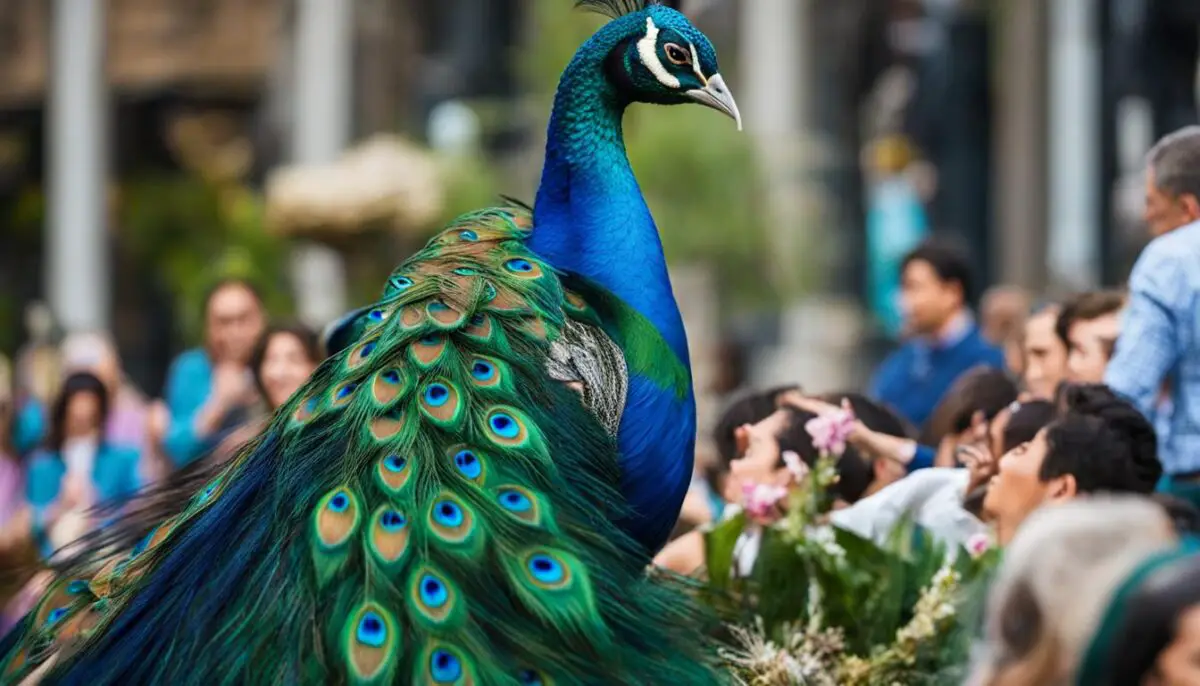
Peacock-Inspired Fashion and Design Examples:
- A high-end fashion brand creating a collection featuring dresses adorned with intricate peacock feather patterns and embroidery.
- An interior designer incorporating peacock feather motifs into wallpaper and upholstery, adding a touch of elegance to a luxurious living space.
- A jewelry designer using peacock feathers as inspiration for a line of statement necklaces, capturing the graceful and captivating qualities of these birds.
- A textile designer experimenting with the iridescent qualities of peacock feathers to create unique fabric finishes for upholstery and drapery.
The use of peacock feathers in fashion and design allows individuals to bring a sense of beauty, nature, and cultural richness into their lives. Whether it’s through a stunning couture gown or a beautifully crafted home accessory, peacock-inspired creations continue to captivate and inspire.
Conclusion
In conclusion, the world of peafowl colors is a mesmerizing one. With a staggering variety of 225 recognized varieties, including pattern mutations and color mutations, these birds never fail to amaze. From the classic blues and greens to the rare and unique shades like white and red, the peafowl’s plumage is a testament to nature’s endless creativity.
The diversity of peacock color patterns adds to their allure, making each individual bird a work of art. Whether it’s the vibrant hues of the Indian peafowl, the metallic blues of the green peafowl, or the subdued iridescence of the Congo peafowl, their plumage never fails to captivate the eye.
Peacock colors play a significant role in fashion, design, and even cultural practices, symbolizing elegance, beauty, and regality. Their feathers have been incorporated into various creative endeavors, adding a touch of sophistication and brightness.
Overall, the peafowl’s colors and plumage are a true wonder of nature. Their stunning variety and intricate patterns make them a sight to behold, leaving us in awe of the beauty and diversity found in these magnificent birds.
FAQ
How many species of peacocks are there?
There are three main species of peacocks: Indian peafowl, green peafowl, and Congo peafowl.
How many varieties of peafowl are recognized by the United Peafowl Association?
The United Peafowl Association recognizes 225 different varieties of peafowl.
How do peacock feathers achieve their vibrant colors?
Peacock feathers achieve their vibrant colors through structural coloration, with tiny structures reflecting light to produce iridescent shades.
What are some common and rare peacock colors?
Some common peacock colors include blue, brown, green, and yellow. Rare colors include white, red, purple, and pink.
What is the purpose of the peacock’s crest?
The peacock’s crest serves important sensory functions by helping the bird detect vibrations, communicate with others, and avoid predators.
What are the ethical considerations of obtaining peacock feathers?
Obtaining peacock feathers raises questions about the welfare of the birds, the impact on the environment, and respect for cultural traditions.
How can male and female peafowl be distinguished?
Male peafowl have vibrant, colorful feathers, while female peafowl have more muted and camouflaged feathers.
Are there lesser-known varieties of peacocks?
Yes, there are lesser-known varieties of peacocks, such as the Javanese Green Peafowl.
How do peacock feathers contribute to fashion and design?
Peacock feathers have been used for decoration, fashion, art, and religious practices, adding elegance and brightness to various creative endeavors.
What is the significance of peacock colors and plumage?
Peacock colors and plumage symbolize the majestic beauty of these unique birds and captivate artists, designers, and wildlife enthusiasts.


